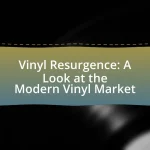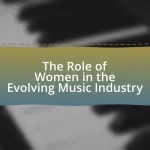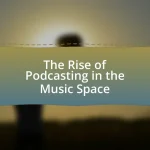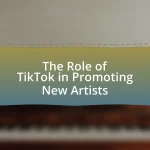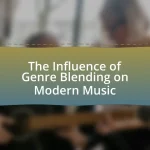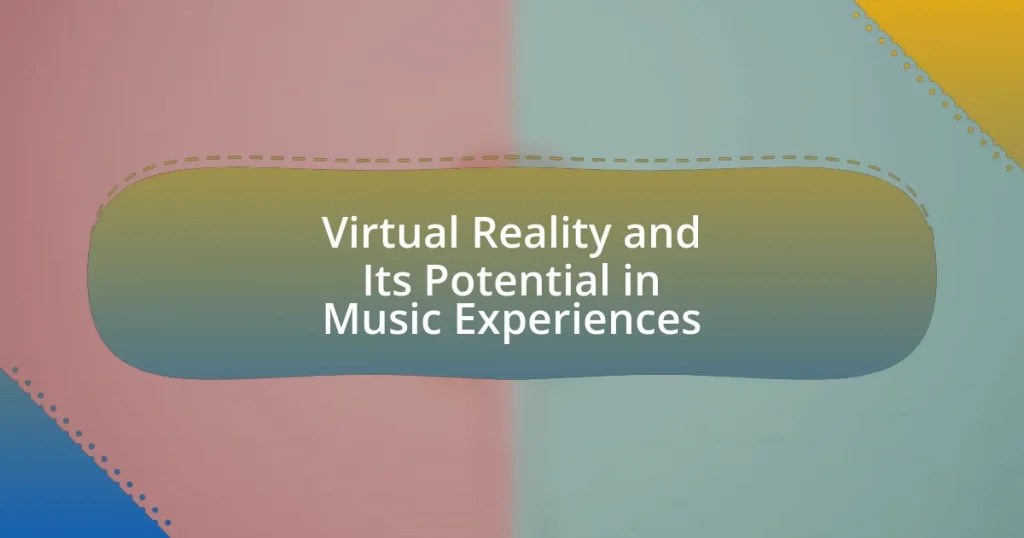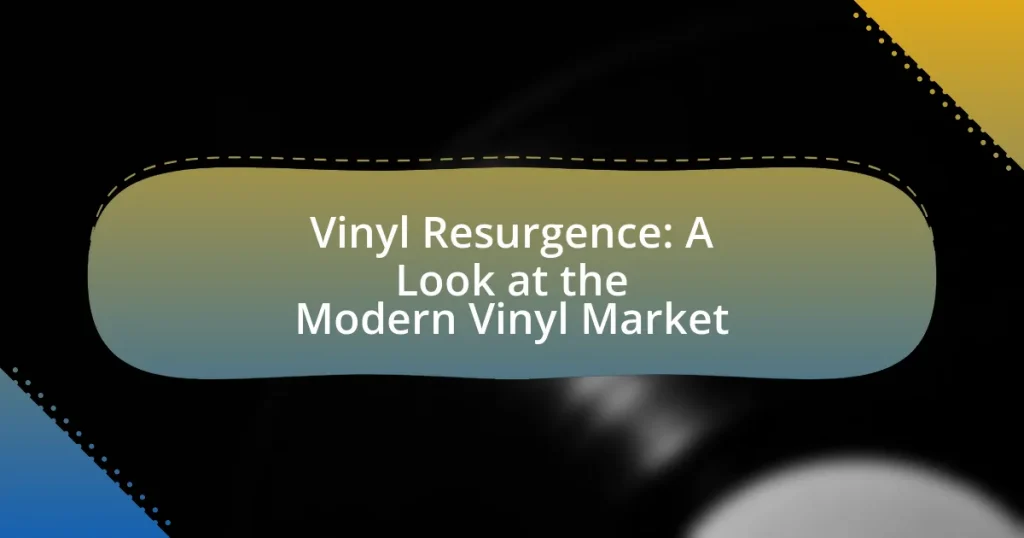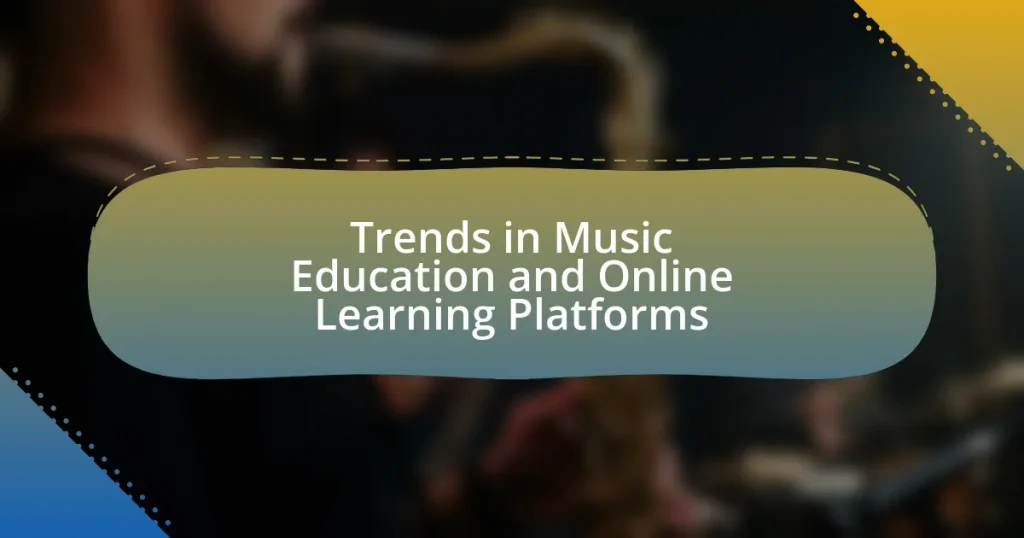The article examines the influence of genre blending on modern music, highlighting its role in fostering innovation and expanding creative boundaries. It discusses the evolution of genre blending in the music industry, driven by technological advancements and cultural exchanges, and provides historical context for its rise. The significance of genre blending is emphasized through its impact on artist creativity, audience engagement, and commercial success, with notable examples and techniques outlined. Additionally, the article explores the societal implications of genre blending, including its reflection of cultural diversity and its effects on music marketing and distribution.
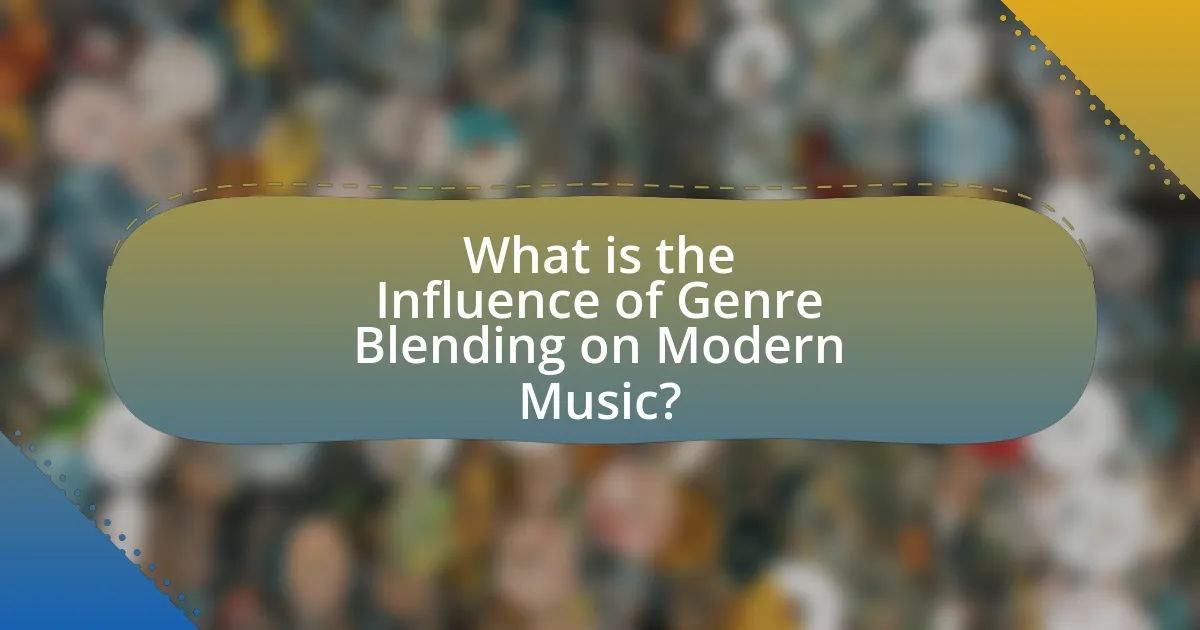
What is the Influence of Genre Blending on Modern Music?
Genre blending significantly influences modern music by fostering innovation and expanding creative boundaries. This phenomenon allows artists to combine elements from various genres, resulting in unique sounds that appeal to diverse audiences. For instance, the fusion of hip-hop and rock has led to the emergence of subgenres like rap-rock, exemplified by bands such as Linkin Park, which achieved commercial success and critical acclaim. Additionally, genre blending has facilitated cross-cultural collaborations, as seen in the rise of reggaeton, which merges Latin rhythms with hip-hop and dancehall influences, leading to global hits. This blending not only enhances artistic expression but also reflects the evolving landscape of music consumption, where listeners increasingly seek diverse and eclectic sounds.
How has genre blending evolved in the music industry?
Genre blending in the music industry has evolved significantly from the mid-20th century to the present day, driven by technological advancements and cultural exchanges. Initially, genres like rock, jazz, and blues began to merge, creating subgenres such as rockabilly and jazz fusion. The rise of digital technology in the 1990s facilitated the mixing of diverse musical styles, leading to the emergence of genres like hip-hop, which incorporates elements from funk, soul, and electronic music.
In the 2000s, platforms like YouTube and Spotify further accelerated genre blending by allowing artists to reach global audiences and collaborate across genres. For instance, artists like Lil Nas X successfully combined country and hip-hop, exemplifying how genre boundaries have become increasingly fluid. According to a 2021 report by the International Federation of the Phonographic Industry, genre-blending tracks accounted for over 30% of the top charts, highlighting its mainstream acceptance and influence on modern music.
What historical factors contributed to the rise of genre blending?
The rise of genre blending can be attributed to several historical factors, including technological advancements, cultural exchanges, and the evolution of music industry practices. Technological advancements, such as the introduction of multitrack recording in the 1960s, allowed artists to experiment with different sounds and styles simultaneously. Cultural exchanges, particularly during the globalization of music in the late 20th century, facilitated the fusion of diverse musical traditions, as seen in the incorporation of reggae, hip-hop, and electronic elements into various genres. Additionally, the music industry’s shift towards genre fluidity in the 1990s encouraged artists to break traditional genre boundaries, leading to the emergence of hybrid genres like country rap and pop-punk. These factors collectively contributed to the widespread acceptance and popularity of genre blending in modern music.
How do technological advancements facilitate genre blending?
Technological advancements facilitate genre blending by providing artists with innovative tools and platforms that enable the seamless integration of diverse musical styles. Digital audio workstations (DAWs), for instance, allow musicians to manipulate sounds from various genres, creating hybrid compositions that were previously difficult to achieve. Additionally, the rise of streaming services and social media platforms has democratized music distribution, allowing artists to reach wider audiences and experiment with genre combinations without the constraints of traditional music industry gatekeeping. This accessibility has led to a surge in genre-blending collaborations, as evidenced by the popularity of tracks that fuse elements from hip-hop, electronic, rock, and pop, reflecting a more interconnected musical landscape.
Why is genre blending significant in today’s music landscape?
Genre blending is significant in today’s music landscape because it fosters innovation and expands audience reach. By combining elements from different genres, artists create unique sounds that attract diverse listener demographics. For instance, the rise of genres like country-rap, exemplified by Lil Nas X’s “Old Town Road,” showcases how blending can lead to mainstream success, breaking traditional genre barriers. This trend is supported by data from the Recording Industry Association of America, which indicates that genre-blending tracks often achieve higher streaming numbers and chart placements, reflecting their broad appeal.
What impact does genre blending have on artist creativity?
Genre blending significantly enhances artist creativity by allowing musicians to explore diverse influences and innovate beyond traditional boundaries. This fusion of styles encourages experimentation, leading to unique soundscapes that can attract wider audiences. For instance, artists like Billie Eilish and Lil Nas X have successfully merged pop with elements of hip-hop and country, respectively, resulting in chart-topping hits that showcase their creative versatility. Research indicates that genre-blending can stimulate cognitive flexibility, enabling artists to draw from various musical traditions and create original works that resonate with listeners across different demographics.
How does genre blending affect audience engagement and preferences?
Genre blending significantly enhances audience engagement and preferences by creating diverse musical experiences that appeal to a broader range of listeners. This fusion of styles allows artists to attract fans from multiple genres, increasing their reach and fostering a more inclusive musical landscape. For instance, the collaboration between hip-hop and country in songs like “Old Town Road” by Lil Nas X not only topped charts but also engaged listeners from both genres, demonstrating how genre blending can lead to unprecedented popularity and listener interaction. Research indicates that genre-blending tracks often receive higher streaming numbers and social media engagement, as they resonate with varied audience demographics, thus validating the positive impact of this musical approach on audience preferences.

What are the key characteristics of genre blending in modern music?
Genre blending in modern music is characterized by the fusion of distinct musical styles, resulting in innovative soundscapes. This blending often involves the incorporation of elements from genres such as hip-hop, rock, electronic, and jazz, creating hybrid forms that appeal to diverse audiences. For instance, artists like Billie Eilish combine pop with electronic and indie influences, showcasing how genre blending can redefine traditional boundaries. Additionally, the rise of digital production tools has facilitated this experimentation, allowing musicians to easily mix and match genres, as seen in the works of artists like Lil Nas X, who merges country with hip-hop. This trend reflects a broader cultural shift towards inclusivity and diversity in music, as listeners increasingly seek out unique and varied auditory experiences.
How do artists incorporate multiple genres into their work?
Artists incorporate multiple genres into their work by blending elements from different musical styles to create innovative sounds. This genre fusion allows artists to reach diverse audiences and express their creativity more freely. For instance, the collaboration between hip-hop and rock has led to the emergence of subgenres like rap-rock, exemplified by bands such as Linkin Park. Additionally, artists like Billie Eilish combine pop with electronic and indie influences, showcasing how genre blending can enhance emotional depth and appeal. This practice is supported by the rise of digital platforms, which facilitate access to various musical influences, enabling artists to experiment and redefine traditional genre boundaries.
What techniques do musicians use to blend genres effectively?
Musicians use techniques such as hybrid instrumentation, cross-genre collaborations, and innovative production methods to blend genres effectively. Hybrid instrumentation involves combining instruments from different genres, like using a sitar in rock music, which creates a unique sound that draws from both traditions. Cross-genre collaborations allow artists to merge their distinct styles, as seen in projects like the collaboration between country artist Lil Nas X and rapper Billy Ray Cyrus, which resulted in the genre-defying hit “Old Town Road.” Innovative production methods, such as sampling and electronic manipulation, enable musicians to incorporate elements from various genres seamlessly, exemplified by artists like Billie Eilish, who blends pop with electronic and indie influences. These techniques demonstrate how musicians can create new sounds by effectively merging different musical styles.
How does collaboration between artists from different genres influence the outcome?
Collaboration between artists from different genres significantly enhances creativity and innovation in music production. This blending of diverse musical styles often results in unique sounds that attract wider audiences, as evidenced by the success of cross-genre collaborations like the partnership between Lil Nas X and Billy Ray Cyrus on “Old Town Road,” which combined country and hip-hop elements, leading to record-breaking chart performance. Such collaborations not only expand artistic boundaries but also foster cultural exchange, allowing artists to experiment with new techniques and ideas, ultimately enriching the music landscape.
What are some notable examples of genre blending in modern music?
Notable examples of genre blending in modern music include the fusion of hip-hop and rock, as seen in collaborations like Linkin Park and Jay-Z’s “Collision Course,” which combines rap verses with rock instrumentation. Another example is the blending of country and pop, exemplified by artists like Kacey Musgraves, whose album “Golden Hour” incorporates pop elements into traditional country music. Additionally, the genre of reggaeton has merged with various styles, such as pop and trap, with artists like Bad Bunny leading this trend. These examples illustrate how genre blending creates innovative sounds and expands the boundaries of musical expression.
Which artists are recognized for their genre-blending styles?
Artists recognized for their genre-blending styles include Billie Eilish, who combines pop, electronic, and alternative influences, and Lil Nas X, known for merging country with hip-hop. Eilish’s debut album “When We All Fall Asleep, Where Do We Go?” showcases her eclectic sound, while Lil Nas X’s hit “Old Town Road” exemplifies the successful fusion of genres, topping charts across multiple categories. These artists illustrate the growing trend of genre-blending in modern music, reflecting diverse influences and appealing to a wide audience.
What songs or albums exemplify successful genre blending?
“Hybrid Theory” by Linkin Park exemplifies successful genre blending, combining rock, hip-hop, and electronic elements. This album, released in 1999, achieved critical acclaim and commercial success, selling over 10 million copies in the U.S. alone. Another notable example is “Stankonia” by OutKast, which merges hip-hop with funk, rock, and electronic music, earning a Grammy Award for Album of the Year in 2002. Additionally, “Random Access Memories” by Daft Punk showcases a blend of electronic, disco, and funk, winning the Grammy for Album of the Year in 2014. These albums illustrate how genre blending can create innovative sounds and reach diverse audiences.
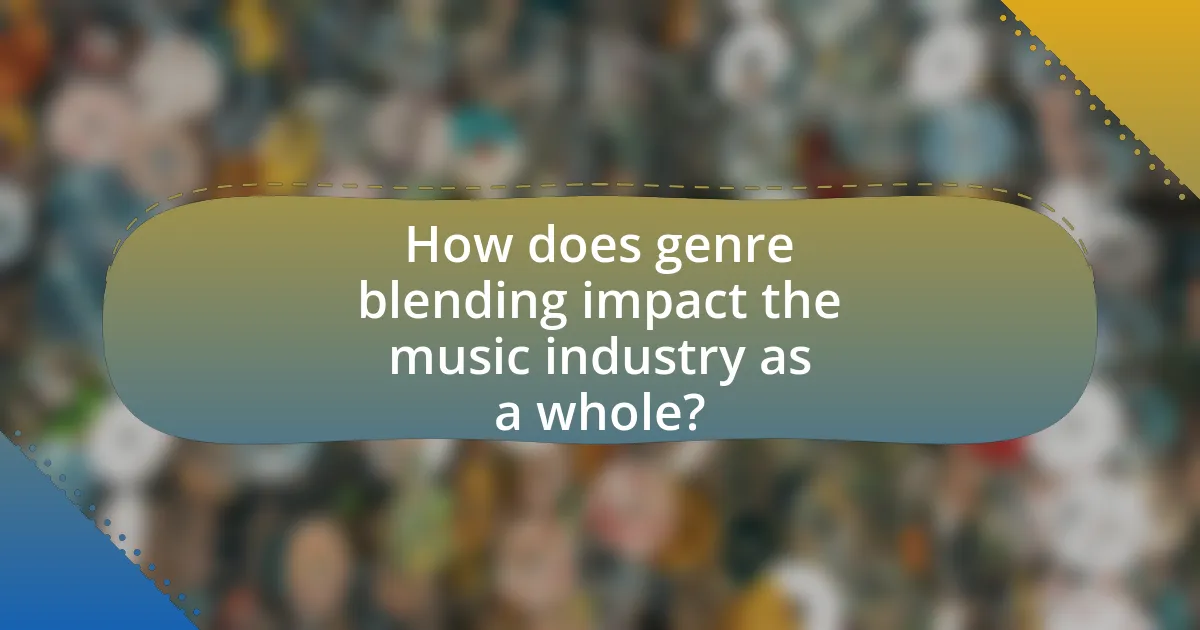
How does genre blending impact the music industry as a whole?
Genre blending significantly impacts the music industry by fostering innovation and expanding audience reach. This phenomenon allows artists to combine elements from different genres, resulting in unique sounds that attract diverse listener demographics. For instance, the rise of genres like country-rap, exemplified by artists such as Lil Nas X with “Old Town Road,” demonstrates how blending can create viral hits that dominate charts and streaming platforms. According to a report by Nielsen Music, genre-blending tracks have seen a 30% increase in streaming, indicating a growing consumer preference for hybrid music styles. This trend not only influences sales and streaming metrics but also encourages collaborations across genres, leading to a more interconnected and dynamic music landscape.
What are the commercial implications of genre blending?
Genre blending has significant commercial implications, as it allows artists to reach broader audiences and tap into multiple market segments. By combining elements from different genres, musicians can attract fans from various backgrounds, thereby increasing their potential sales and streaming numbers. For instance, the rise of pop-rap has led to a surge in popularity for artists like Post Malone, who blends hip-hop with pop, resulting in chart-topping hits and substantial revenue growth. Additionally, genre blending can create unique marketing opportunities, as brands often seek to associate with innovative and diverse musical styles to appeal to younger demographics. This trend is supported by data showing that genre-blending tracks often perform better on streaming platforms, leading to higher visibility and profitability for artists and record labels alike.
How does genre blending influence music marketing and distribution?
Genre blending significantly influences music marketing and distribution by expanding target audiences and creating unique branding opportunities. When artists combine elements from different genres, they attract diverse listener demographics, which allows for more tailored marketing strategies. For instance, the rise of genres like country-rap has led to collaborations that appeal to fans of both styles, thereby increasing streaming numbers and sales. According to a 2021 report by the International Federation of the Phonographic Industry, genre-blending tracks accounted for over 30% of the top-streamed songs, demonstrating their commercial viability. This trend encourages record labels to invest in cross-genre collaborations, enhancing distribution channels across various platforms to maximize reach and engagement.
What role does genre blending play in music awards and recognition?
Genre blending significantly enhances the chances of artists receiving music awards and recognition. This phenomenon allows musicians to reach broader audiences by combining elements from different genres, which can lead to innovative sounds that resonate with diverse listener demographics. For instance, the Grammy Awards have increasingly recognized genre-blending works, as seen in categories like Best Pop Vocal Album, where artists such as Billie Eilish and Lil Nas X have won for projects that incorporate pop, hip-hop, and electronic influences. This trend reflects the industry’s shift towards valuing creativity and cross-genre collaboration, ultimately influencing award nominations and wins.
How does genre blending shape cultural trends in music?
Genre blending shapes cultural trends in music by fostering innovation and expanding audience reach. This fusion of styles, such as hip-hop with country or rock with electronic, creates new sounds that attract diverse listeners and challenge traditional genre boundaries. For instance, the collaboration between Lil Nas X and Billy Ray Cyrus on “Old Town Road” exemplifies how genre blending can lead to viral success and reshape charts, as it topped the Billboard Hot 100 for a record-breaking 19 weeks in 2019. Such cross-genre collaborations not only reflect changing musical tastes but also influence fashion, language, and social movements, demonstrating the profound impact of genre blending on contemporary culture.
What are the societal implications of genre-blending music?
Genre-blending music has significant societal implications, as it fosters cultural exchange and challenges traditional musical boundaries. By merging different genres, artists create innovative sounds that reflect diverse influences, promoting inclusivity and collaboration among various cultural groups. This blending can lead to increased acceptance of multiculturalism in society, as listeners are exposed to a wider range of musical styles and cultural narratives. For instance, the rise of genres like reggaeton, which combines Latin rhythms with hip-hop and dancehall, has not only gained global popularity but also highlighted the cultural contributions of Latinx communities in mainstream music. Furthermore, genre-blending can disrupt established music industry norms, encouraging independent artists to experiment and reach broader audiences, thereby democratizing music production and consumption.
How does genre blending reflect and influence cultural diversity?
Genre blending reflects and influences cultural diversity by merging distinct musical styles, which fosters cross-cultural exchange and innovation. This phenomenon allows artists to draw from various cultural backgrounds, creating hybrid genres that resonate with diverse audiences. For example, the rise of genres like reggaeton, which combines Latin rhythms with hip-hop and dancehall, illustrates how cultural elements can intertwine to form new musical expressions. Additionally, studies show that genre-blending music often promotes inclusivity and understanding among different cultural groups, as seen in collaborations between artists from varied ethnic backgrounds, such as the partnership between Shakira and Wyclef Jean. This collaboration not only showcases the blending of musical traditions but also highlights the shared human experience, reinforcing the idea that music serves as a universal language that transcends cultural boundaries.
What practical tips can artists use to successfully blend genres?
Artists can successfully blend genres by experimenting with different musical elements, such as rhythm, melody, and instrumentation. This approach allows artists to create unique sounds that draw from multiple influences. For instance, incorporating elements from jazz into a pop song can introduce complex harmonies and improvisation, while fusing electronic beats with traditional folk music can create a fresh auditory experience. Additionally, studying successful genre-blending artists, like Billie Eilish or Lil Nas X, can provide insights into effective techniques and audience reception. These artists often combine diverse influences, demonstrating that genre blending can lead to innovative and commercially successful music.
How can musicians identify and experiment with different genres?
Musicians can identify and experiment with different genres by actively listening to a wide variety of music styles and analyzing their characteristics. This involves studying elements such as rhythm, melody, harmony, instrumentation, and lyrical themes across genres like jazz, rock, hip-hop, and classical. Engaging in genre-specific workshops or collaborating with artists from diverse musical backgrounds further enhances their understanding and ability to blend genres. Research indicates that genre blending can lead to innovative sounds, as seen in the rise of artists like Billie Eilish, who incorporates elements from pop, electronic, and indie music, demonstrating the creative potential of cross-genre experimentation.
What resources are available for artists looking to explore genre blending?
Artists looking to explore genre blending can utilize various resources, including online platforms, workshops, and collaborative networks. Online platforms such as SoundCloud and Bandcamp allow artists to share and discover genre-blending music, facilitating inspiration and collaboration. Workshops offered by organizations like Berklee College of Music provide hands-on experience in mixing genres, while collaborative networks like Splice connect artists with diverse musicians, enabling genre experimentation. These resources support artists in expanding their creative boundaries and developing unique sounds.

